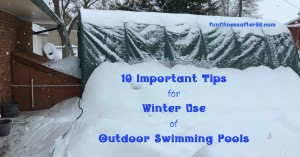Plan for winter when you build your swimming pool
Swimming pools are often built in the warm months, when you might not be thinking of potential winter use or realize what that would involve. But especially, a smaller exercise pool can be reasonably set up for winter use.
If you want to use your swimming pool year round and you have any sort of freezing winter, you need to think ahead. Preferably you will think ahead while building or installing it, but if you didn’t there might still be some things you can do!
Important tips for winter swimming pools
- Have a temporary tent to put over it. Either intense cold or heavy precipitation can greatly inhibit your enjoyment of or access to your outdoor swimming pool. We have used a portable garage to cover my swimming pool for several winters now. It makes a huge difference to have that for the harshest months. It does mean that we need to put it up before the weather gets too bad, though.
- Make sure you have a way to put water into the pool when outside faucets are either turned off or frozen. For me, that means keeping a hose in my greenhouse so that the water doesn’t freeze inside of it. There are ways to attach hoses to indoor faucets, but beware of trying to use a hose with your water heater to put in hot water. Hoses are not made to withstand such temperatures and may burst, flooding the associated region of the house.
- Have a well functioning swimming pool water heater. I suppose it is technically possible to set up some sort of solar water heating in the winter, but I haven’t seen anything that impresses me. You don’t want the pipes to your swimming pool freezing.
- Go ahead and turn that heater up a couple of degrees. It is one thing to get into cool water when it is above 80°F and sunny outside. It is discouraging to do so in the cold wet weather. Just a raising my swimming pools temperature to 82° (from the 80°F that I had been keeping it) made it so much more comfortable for winter swimming.
- Have an insulating cover directly on top of the water while the swimming pool is not in use. This will help keep energy costs down.
- Consider how the swimming pool cover will be opened and closed with the temporary tent in place. The tent may obstruct access to things that are not obvious at first.
- Make sure your core body temperature is on the warm side before swimming. I like to do this while inside the house, so that the walk to the pool isn’t painful from the lower winter temperatures or cutting winds.
- Have a path to your pool that is comparatively easy to maintain during snow or wind. Even if you have a covered walkway, there is likely to be blowing of snow or debris. That will be easiest to remove if the path is firm and level, such as a concrete walk. This is also important for keeping doors into the pool area functional.
- Make sure you still have good access to all the swimming pool machinery, such as heater and filter. I find that during the winter the water stays cleaner, but it still occasionally needs to be backwashed to keep the filter working and water flowing through the heater.
- Appropriately protect the heater and filter from extremes of temperature and weather. My husband built this insulated lean-to shed against the garage and it has worked wonderfully!
Here is a very short video showing how I get water to my pool in spite of heavy snowfalls.
I have thoroughly enjoyed being able to swim just out my back door no matter what the weather. Even if the roads are dangerous or impassable, I get to swim.

